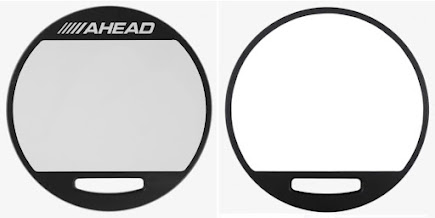While the specialty pads that get the most press are focused on the marching arts, there’s a subset of practice pads designed for practicing brushes on.
When I was in college, my Dad played piano bar at a downtown nightclub. Very occasionally, I’d bring my brushes with me, and Dad would pull out the Yellow Pages, open them on the bar and let me quietly keep time while he played. The opened phone book had a great surface for brushes.
And it was free.
Since then, several drum companies have produced brush practice pads, with varying degrees of success.
Here are just a few that I’ve tried:
1. Remo Brush-Up pad. Designed with input from Ed Thigpen, a renowned master of brush playing, this was essentially a stiff rubber frame with a Remo Fyberskyn surface laid over a foam rubber mute. The pad worked as advertised, and was very quiet, but sold poorly and was only in production for a few years. If you can find one for sale online today, expect to pay several hundred dollars for it.
2. Brush Up pad by One Beat Better. This was panel of wood with rubber nonskid strips on bottom and a clear textured coating on top. There was also a partial rim so you could practice rim rolls. Designed with input by Sherrie Maricle, this was a really nice practice item, just small enough to fit on top of a snare drum. It appears to be no longer available at this writing.
3. Ahead 14-inch Brush Pad. Basic and useful, with a rubber side for stick practice and a textured side for brush practice. It just fits on a snare drum, or on a stand or tabletop. And it’s still available.
4. Attacktile by Evans. A recent entry into the market, this is an Evans rubber practice pad, based on MDF and topped by a rigid, textured layer. The playing surface is nice for brushes, but for some reason Evans chose to make this pad in a ten-inch size — not really large enough to practice full brush strokes. Also, the rigid surface has shown evidence of coming away from the base after a month or less of use, showing that the adhesion may need some more work. With adhesion improvement and a 14-inch size, this might be a really nice brush pad, but in my opinion the design needs some work.

5. Percussion Practice Pad by Pete Siers. Siers, a drummer and drum teacher, designed and made up a batch of these pads from Formica tile and at this writing is selling them online. The pad fits on top of a snare drum, but is also rigid enough to sit in a stand or on a tabletop. While the shiny side is the one intended for brushwork, I’ve found that the underside also works for a slightly different feel and sound. I recently acquired one of these and like it a lot.
If the price of a brush-specific pad seems prohibitive — and I can’t blame you — you can look around for an old phone book. Or, since those are getting a lot harder to find in the Electronic Age, a 14” square or round of corrugated cardboard also works very well.






































